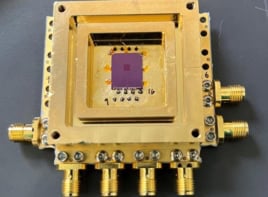Transistors are invariably made of semiconducting materials, but the special properties of superconducting materials make them attractive for some, highly demanding, applications. Indeed, physicists have been trying to build superconducting devices with transistor-like properties - in particular devices that can amplify electrical currents - for more than 20 years. Now Giampiero Pepe of the University of Naples in Italy and colleagues led by Antonio Barone, together with Norman Booth of Oxford University in the UK, have built a superconducting device that exhibits large current amplification and other transistor-like properties (G P Pepe et al. 2000 Appl. Phys. Lett. 77 447). The device can also be operated to obtain negative current gain, which is not possible with semiconductor devices.
The device has three electrodes: a niobium injector electrode; a common electrode that consists of a layer of niobium and a layer of aluminium; and a niobium detector electrode. The electrodes are separated by insulating barriers, or junctions, through which current can pass by quantum tunnelling. At the operating temperature of 4.2 Kelvin, all the niobium layers are superconducting. In the absence of any injected current, the aluminium layer is also superconducting, as a result of the proximity effect. In a superconducting metal the electrons form pairs, and an amount of energy equal to the superconducting energy gap is needed to split a pair.
The operation of the device can be understood in terms of electrons that are injected into the common electrode. When the injection current is small, the aluminium layer remains superconducting, with an energy gap that is lower than that of niobium. The electrons become trapped in the aluminium layer, but each one is capable of splitting at most one pair of electrons, so relatively few electrons reach the detector electrode. Thus, the current gain is low.
But this changes when the injected current is increased. The aluminium layer is then no longer superconducting, so its energy gap vanishes and the injected electrons increase the temperature enough for a large number of electrons to tunnel through the detector junction. Indeed, the Naples-Oxford team observed current gains of more than 50 and signal power gains as high as 1000.
Such devices could be exploited in a wide range of cryogenic particle and radiation detectors in both astrophysics and particle physics (N E Booth et al. 1999 Supercond. Sci. Technol. 12 538).



